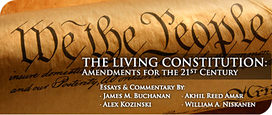Prof. Buchanan’ initial essay and his response illustrate the problems of translating even broadly shared principles into constitutional language. A discussion of principles, however, is only the first stage of a constitutional dialogue. Specific proposed language is a necessary next step, both to clarify the implication of the principle and to test the support for the specific language.
Prof. Amar’s second response, I suggest, misinterprets the effect of the 17th Amendment. He claims that “… the Amendment has created an important pool of democratically-selected and foreign-policy savvy leaders who are plausible presidential candidates.” Before the amendment, however, the Senate had included such generally recognized leaders as Calhoun, Clay, Seward, and Webster, all of whom later served as Secretary of State and/or as a candidate for president. After the amendment, the only two presidents to be directly elected from the Senate were Harding and Kennedy, both of whom died in office following an undistinguished record. Amar also misdescribes a repeal of the 17th Amendment as a “states’ rights” modification; the primary effect of a repeal of this amendment would be to restore the role of the states in the routine decisions of the federal government. Most of Prof. Amar’s proposed amendments would be to further “democratize” the Constitution, without explaining how this would improve the performance of the government.
I am surprised that none of us mentioned one of the most ambiguous features of the Constitution: the potential conflict between the unenumerated (9th Amendment) rights of individuals and the unenumerated (10th Amendment) powers of the states. Many of the more controversial decisions by the Supreme Court involve taking one or the other side of this conflict. I mention this issue primarily because I have no idea about how to resolve this conflict and would value your suggestions.

